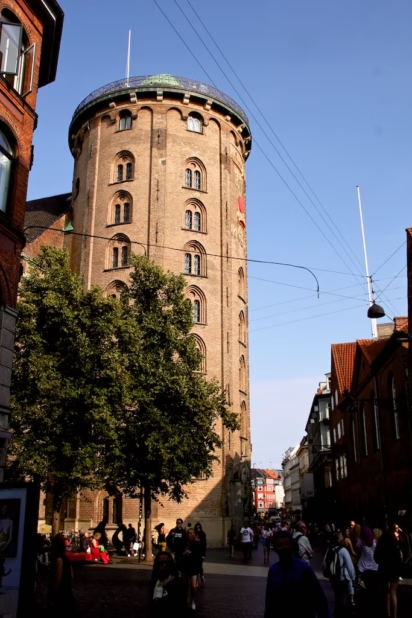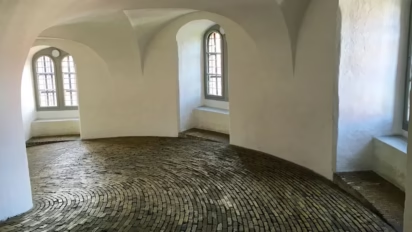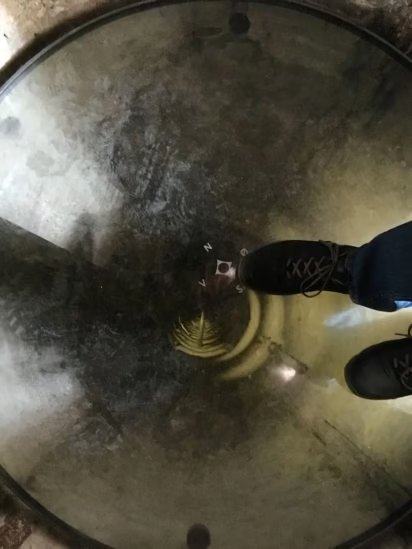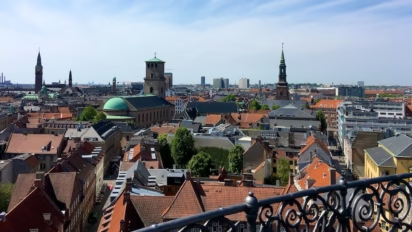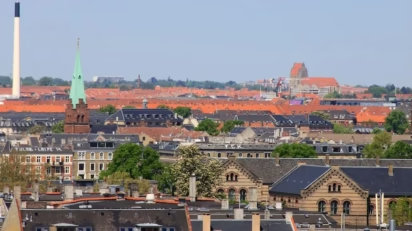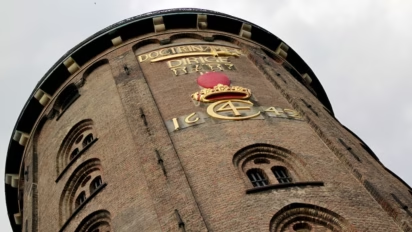Some of the best views of Copenhagen are from the Rundetaarn observation tower in the center of the old town – a simple stroll up a spiral walkway ramp.
The Rundetaarn attached to the Trinitatis Kirke in Copenhagen gives some of the finest aerial views of the city, harbor, and surrounding seas. Visitors walk up the gentle slopes of a wide spiral ramp with just a few stairs right at the top leading to the big spectator’s platform and Europe’s oldest functioning astronomy observatory. The round tower viewing platform is open every day.
The Rundetaarn (Round Tower) in Copenhagen
The Rundetaan (literally Round Tower) is a prominent landmark in the heart of Copenhagen’s old town. It is attached like a bell tower to the Trinitatis Kirke (Trinity Church) and although it does have bells, its original purpose has been as an astronomy observatory, a function it is still able to fulfill today.
The Rundetaarn was erected, like so many other buildings in Copenhagen, by King Christian IV (his gilded C4 features prominently on the outside). The 34.8-m high tower was completed in 1642 to serve as an observatory while the spiraling ramp walkway gave access to the university library installed in the loft of the adjacent Trinitatis Kirke.
The Rundetaarn is famous for its 209-m spiral ramp that allows visitors to walk through 7.5 loops to the top. A ramp, rather than stairs, was built to allow the easier transportation of the heavy and sensitive astronomical instruments to the top.
This also allowed Czar Peter the Great to ride his horse, with the czarina following by horse-drawn carriage, to the top to enjoy the views in 1716.
In 1902, a German tourist drove a car to the top, as Copenhagen’s lack of hills presented no other suitable challenge to demonstrate the power of his Benz Gaggenau’s engine. Cycling and unicycle races are also sometimes held.
Visiting the Rundetaarn
Visitors pay admission at ground level and then simply stroll up the Rundetaarn with a few stops possible en route:
The old library (Bibliotekssalen) is around halfway up but has a disappointingly modern fitting. It is used for changing exhibitions and cultural events with a small shop and kiosk for drinks and snacks. This was originally the main library of the university but closed in 1861 when the collection exceeded 10,000 volumes.
One level up is the bell loft (Ringerloftets) with pine timber fitted after the 1729 Copenhagen fire. Here are modern toilets with the original privy nearby off the spiral walkway – visitors may sit but not actually use the original.
A small doorway 25 m up leads to a glass platform over the hollow core of the tower. This was the geographical point zero selected for the map made of Denmark in the 1760s. A choir boy survived a fall down the pit in 1880 – he was missing and unconscious for a day but with just a few scrapes on his arm and a couple of teeth missing it was all considered, from a Danish perspective, very little harm done.
Just before the spiral staircase leading to the viewing platform is a tridimensional model of the solar system installed in 1928. It replaced the original planetarium that showed both the Copernican system with the sun at the center and the divergent system by Tycho Brahe that still had the earth at its center.
A final couple of narrow stairs lead to the large open viewing platform. From here, visitors may enjoy some of the finest views of Copenhagen. In contrast to the Vor Frelser Kirke spiral, there is no need to hang on for life – it is a solid, safe platform with fine views in all directions. The wrought-iron lattice was made in 1643 by Kaspar Fincke. The C4 and RFP represent King Christian IV and his motto: Regna Firmat Pietas – Piety Strengthen the Realms.
In addition to the old town sites, also look further in the distance for landmarks such as the yellow Frederiksberg Castle and Zoo tower, the expressionist Grundtvig’s Church, passenger cruise boats, the modern department and office development in the former harbor areas, off-shore windmills and the Øresund bridge connecting Denmark and Sweden by road and rail.
The Oldest Working Observatory in Europe
At the top of the Rundetaarn is Europe’s oldest still-functioning astronomy observatory. The purpose of the round tower was to give the university an observatory high above the city lights and it was used until 1861.
Ever since the university had moved out, amateur astronomers were allowed to explore the skies from here. The current equipment is from 1929. The 6.75 by 6 m observatory had a refracting telescope with 80-450 x magnification.
The observatory is usually only open to visitors on Tuesday and Wednesday from mid-October to mid-March from 19:00 to 21:00. Sun-viewing sessions are offered on some summer Sundays. No additional charge.
Visiting the Rundetaarn Viewing Platform in Copenhagen
The Rundetaarn, Købmagergade 52A, 1150 Copenhagen K, tel +45 33 73 03 73, is located in the old town pedestrian zone between Nørreport station and Strøget, or between Rosenborg Palace and the university / Copenhagen Cathedral.
The Rundetaarn viewing tower in Copenhagen is open daily from 10:00 to 18:00, closing at 20:00 from late May to late September. During the winter season, the tower is usually open until 21:00 on Tuesday and Wednesday.
The tower is only closed on December 24 and 25 and January 1.
Admission is DKK25 (DKK5 for children 5 to 15 years).
The Copenhagen Card is valid.
The tower is not suitable for wheelchairs or prams, although smaller strollers are usually allowed.
Other Sights near the Rundetaarn
Other sights near the Round Tower include the adjacent Trinitatis Kirke with its baroque interior while the neo-classical Domkirke, old university, and Renaissance Rosenborg Palace in the King’s Garden are also nearby.
For similar fine views of Copenhagen, the more adventurous may scale the tower of the Vor Frelser Kirke with its famous anticlockwise twisting external staircase leading to the top of its spire. The highest viewpoint is from the town hall tower that may only be seen on guided tours.
Even easier, and free, is the Christiansborg Palace tower in the parliamentary complex that may be ascended by elevator but queueing and airport-style security could be an issue.

